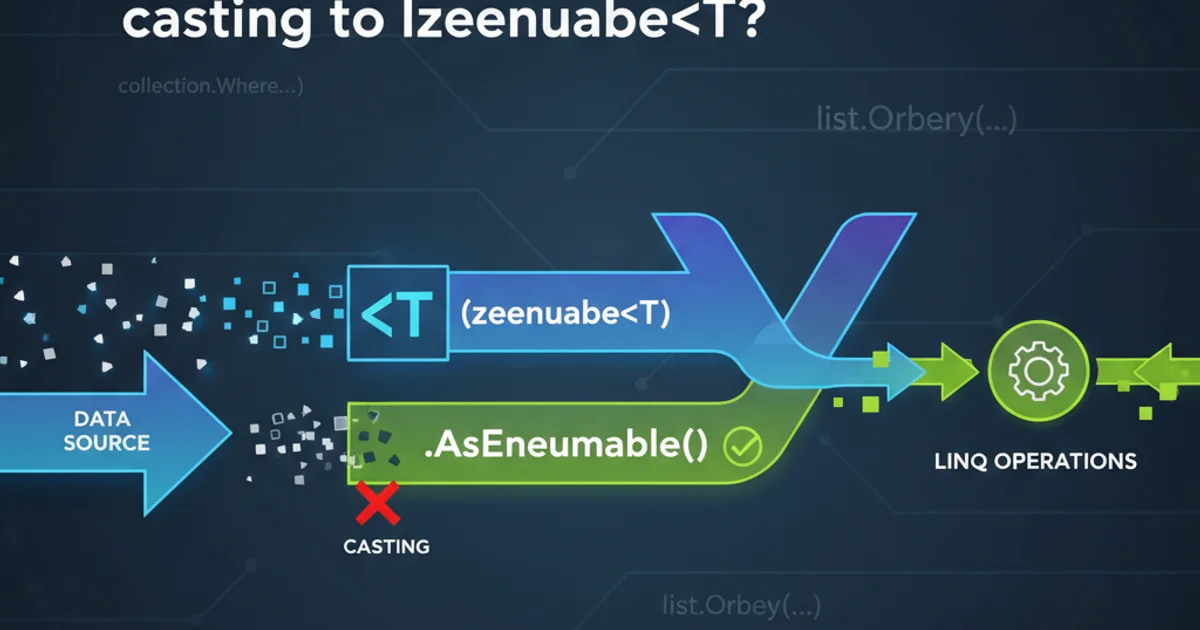Why use .AsEnumerable() rather than casting to IEnumerable<T>?
Categories:
Understanding .AsEnumerable() vs. Casting to IEnumerable in C# LINQ

Explore the subtle yet significant differences between using the .AsEnumerable() extension method and directly casting to IEnumerable<T> in C# LINQ queries, and learn when to use each for optimal performance and behavior.
When working with LINQ in C#, you often encounter scenarios where you need to treat a collection as an IEnumerable<T>. Two common approaches for this are using the .AsEnumerable() extension method or simply casting the collection to IEnumerable<T>. While they might seem similar at first glance, their underlying behavior and implications for query execution can be quite different. This article delves into these differences, helping you make informed decisions in your LINQ queries.
The Basics: Casting to IEnumerable
Casting a collection to IEnumerable<T> is a direct type conversion. When you cast an object that already implements IEnumerable<T> (like List<T>, Array, DbSet<T>, etc.), you are essentially telling the compiler to treat that object as its IEnumerable<T> interface. This operation itself does not change the underlying type or its capabilities; it merely restricts the accessible members to those defined by IEnumerable<T>.
Crucially, when you cast an IQueryable<T> (such as a DbSet<T> from Entity Framework) to IEnumerable<T>, the underlying query provider (e.g., SQL Server) is still in play. Subsequent LINQ operations might still be translated into SQL and executed on the database, depending on the specific query provider's implementation. The cast itself doesn't force immediate execution or switch the query context.
using System.Collections.Generic;
using System.Linq;
public class Product
{
public int Id { get; set; }
public string Name { get; set; }
public decimal Price { get; set; }
}
public class Example
{
public void CastExample()
{
List<Product> products = new List<Product>
{
new Product { Id = 1, Name = "Laptop", Price = 1200.00m },
new Product { Id = 2, Name = "Mouse", Price = 25.00m }
};
// Casting a List<Product> to IEnumerable<Product>
IEnumerable<Product> enumerableProducts = (IEnumerable<Product>)products;
// This still operates on the in-memory list
var cheapProducts = enumerableProducts.Where(p => p.Price < 100);
// If 'products' was an IQueryable<Product> (e.g., from DbSet),
// 'Where' might still be translated to SQL.
}
}
Example of casting a List<T> to IEnumerable<T>.
The .AsEnumerable() Extension Method
The .AsEnumerable() extension method, found in System.Linq, serves a very specific purpose: it explicitly converts an IQueryable<T> (or any collection) into an IEnumerable<T> and, more importantly, forces the remaining part of the query to be executed in-memory using LINQ to Objects.
When .AsEnumerable() is called on an IQueryable<T>, any LINQ operations before .AsEnumerable() are still translated and executed by the IQueryable provider (e.g., in SQL). However, all LINQ operations after .AsEnumerable() will be performed on the data that has already been fetched into memory. This is a critical distinction, especially when dealing with database contexts like Entity Framework.
using System.Collections.Generic;
using System.Linq;
// Assume Product and a DbContext are defined elsewhere
// public class MyDbContext : DbContext { public DbSet<Product> Products { get; set; } }
public class Example
{
public void AsEnumerableExample(MyDbContext context)
{
// Scenario 1: Using AsEnumerable() to force in-memory processing
var expensiveProductsInMemory = context.Products
.Where(p => p.Price > 500) // This part is translated to SQL
.AsEnumerable() // Data fetched from DB into memory
.Where(p => p.Name.Contains("Pro")); // This part is LINQ to Objects
// Scenario 2: AsEnumerable() on an already in-memory collection
List<Product> localProducts = new List<Product>
{
new Product { Id = 1, Name = "Laptop", Price = 1200.00m },
new Product { Id = 2, Name = "Mouse", Price = 25.00m }
};
IEnumerable<Product> enumerableLocalProducts = localProducts.AsEnumerable();
// In this case, it behaves much like a cast, as it's already in-memory.
// The primary impact is on IQueryable<T>.
}
}
Demonstration of .AsEnumerable()'s effect on query execution.
Key Differences and When to Use Which
The core difference lies in where the subsequent LINQ operations are executed. Casting to IEnumerable<T> doesn't necessarily change the query provider, while .AsEnumerable() explicitly switches the execution context from IQueryable (e.g., database) to IEnumerable (in-memory).
Use Casting to IEnumerable<T> when:
- You want to pass an
IQueryable<T>to a method that expectsIEnumerable<T>but you still want the query to be executed by theIQueryableprovider as much as possible. - You are working with an in-memory collection (like
List<T>) and simply need to treat it as its interface type without any change in behavior.
Use .AsEnumerable() when:
- You need to perform complex LINQ operations (e.g., custom methods, unsupported functions) that cannot be translated by the
IQueryableprovider (like Entity Framework) into SQL. - You want to explicitly fetch a subset of data from the database and then perform further filtering, sorting, or projection in your application's memory.
- You want to avoid sending complex or inefficient queries to the database by doing an initial filter on the database and then processing the rest in-memory.
Caution: Using .AsEnumerable() too early in a query can lead to fetching a large amount of data into memory, potentially causing performance issues and increased memory consumption. Always try to filter and project as much as possible at the IQueryable level before switching to IEnumerable.
flowchart TD
A[Start with IQueryable<T>] --> B{LINQ Operations (SQL-translatable)}
B --> C{Cast to IEnumerable<T>}
C --> D{More LINQ Operations}
D --> E[Execution by IQueryable Provider (SQL)]
F[Start with IQueryable<T>] --> G{LINQ Operations (SQL-translatable)}
G --> H[".AsEnumerable()"]
H --> I{More LINQ Operations (LINQ to Objects)}
I --> J[Execution In-Memory]
subgraph Casting
A
B
C
D
E
end
subgraph AsEnumerable()
F
G
H
I
J
endComparison of query execution flow for casting versus .AsEnumerable().
Where), ordering (OrderBy), and projection (Select) operations that can be translated to SQL before calling .AsEnumerable(). This minimizes the data transferred from the database to your application, improving performance.